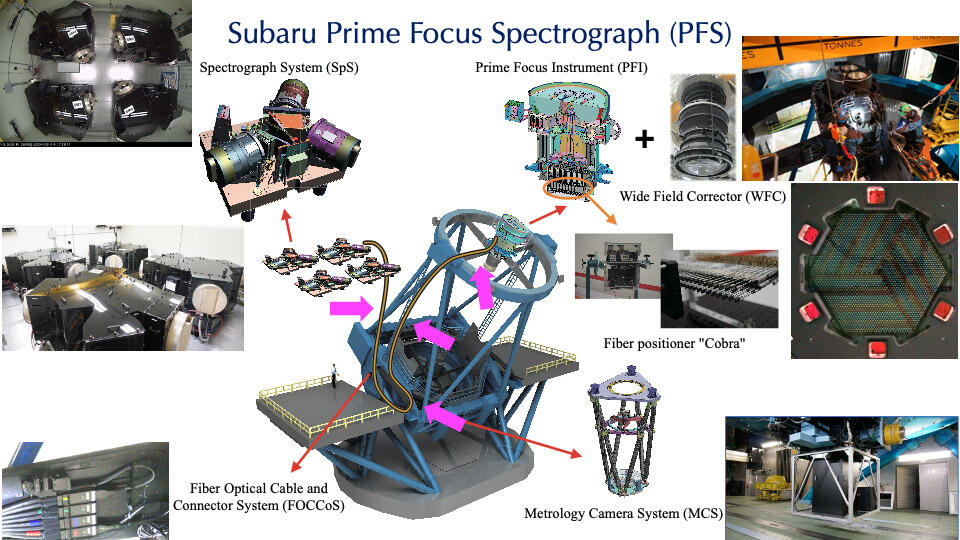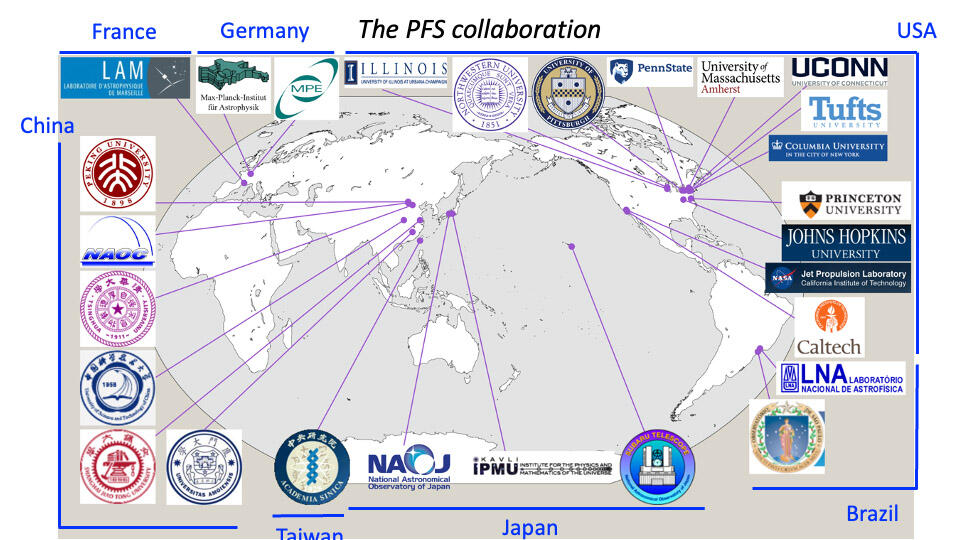Researchers have finished equipping the Subaru Telescope with a new special "compound eye" culminating several years of effort. This new eye is an instrument featuring approximately 2,400 prisms scattered across the extremely wide field of view available at the Subaru Telescope’s primary focus, allowing for simultaneous spectroscopic observation of thousands of celestial objects. This unrivaled capability will help researchers precisely understand the formation and evolution of galaxies and the Universe. Among 8-meter-class telescopes, the Subaru Telescope is the most competitive with the largest survey capability in the world. This instrument, the Prime Focus Spectrograph (PFS), will be ready to begin scientific operations in February 2025.

Figure 1: Example of data obtained by PFS observing celestial objects in the Andromeda Galaxy region. On the left, the positions of the PFS fibers configured to observe individual celestial objects are marked by circles (stars and galaxies for science), squares (bright stars for calibration purposes), and triangles (just to take sky spectra) on an image of the Andromeda Galaxy taken with HSC (Hyper Suprime-Cam) (Credit: HSC Project/NAOJ). The cyan rectangle represents the field of view of the multi-object spectrograph DEIMOS in operation at W. M. Keck Observatory for comparison. On the right, a magnified image of the observed celestial object is shown, along with the spectra obtained by PFS. (Credit: PFS Project/Kavli IPMU/NAOJ)
PFS will be one of the flagship instruments of the "Subaru Telescope 2.0" era. Taking advantage of the Subaru Telescope’s ultrawide field of view, approximately 1.3 degrees in diameter at the prime focus, and world-renowned large light-gathering power, PFS will position 2,400 fibers to collect light from celestial objects and simultaneously obtain spectra across the entire visible light range and part of the near-infrared band (see Figures 1-3). Just like the compound eyes of insects, each facet (fiber) focuses on a different direction to cover a wide area while perceiving the colors of light from that direction. This highly ambitious instrument will dramatically enhance the Subaru Telescope’s spectroscopic observation efficiency.

Figure 2: Schematic of the PFS instrument. It is composed of multiple subsystems installed at various locations on the telescope and throughout the enclosure. Approximately 2,400 optical fibers are distributed within the field of view of the Subaru Telescope's primary focus, precisely directed towards the stars and galaxies to be observed with an accuracy of ~20 micrometers. The light captured by these fibers from numerous celestial objects is sent to the spectrograph system, consisting of four identical modules each of which is equipped with three cameras—"blue," "red," and "near-infrared"—and is simultaneously spectroscopically observed over a wide wavelength range, from 380 nanometers to 1,260 nanometers. (Credit: PFS Project/Kavli IPMU/NAOJ)

Figure 3: Example of data obtained by PFS in a single exposure. The horizontal axis represents the wavelength, ranging from 380 nanometers to 1,260 nanometers. The vertical axis displays the spectra from the ~2400 individual fibers. The brighter yellow regions indicate stronger light. The emission lines from OH molecules in the sky are observed in all fibers, so they appear as continuous lines along the vertical direction in this diagram. On the other hand, the continuous lines appearing along the horizontal axis (wavelength direction) represent the continua spectra from celestial objects. (Credit: PFS Project/Kavli IPMU/NAOJ)
Spanning nearly 15 years with support from industrial partners around the world, the development of PFS has been led by an international collaboration of over 20 research institutions in Japan, the U.S., France, Brazil, Taiwan, Germany, and China (see Figure 4, Note 1). Notably, the University of Tokyo Kavli Institute for the Physics and Mathematics of the Universe (Kavli IPMU, WPI) has taken the lead in proposing and developing the instrument as well as planning large-sky survey observations, with the goal of testing various theoretical models about the formation of the Universe. The National Astronomical Observatory of Japan (NAOJ) has also played a central role, participating in the development of the instrument and overseeing the coordination of the project, while also being responsible for the acceptance and operation of the instrument.

Figure 4: Logos of the institutions participating in the PFS collaboration. (Credit: PFS Project/Kavli IPMU/NAOJ)
Using this powerful instrument, the international team will invest a total of 360 nights of telescope time over the next
five or so years to carry out spectroscopic observations of millions of distant galaxies. By creating a 3D map of the Universe and understanding its time evolution, they aim to uncover the nature of dark energy, which is driving the accelerated expansion of the Universe. In addition, by doing spectroscopic surveys of many galaxies, much like a census, they will reveal the physical processes of galaxy formation and evolution over the 13.8 billion-year history of the Universe. Furthermore, they will spectroscopically observe hundreds of thousands of stars in the Milky Way and Andromeda galaxies, investigating the dynamics of stars to determine the strength of gravity, thus exploring the nature of dark matter and the physical processes that have governed the growth of the galaxies. In this way, PFS will enable the observational study of dark energy, dark matter, and the history of galaxies based on an overwhelming amount of spectroscopic data, elucidating their roles throughout the 13.8 billion-year history of the Universe.
The Principal Investigator (PI) of the PFS project, Hitoshi Murayama (Professor at the University of California, Berkeley, and Professor at the Kavli IPMU, the University of Tokyo Institutes for Advanced Studies), comments, "It is so exciting that we can finally start deploying this incredible instrument. Fifteen years of preparation have finally come to fruition. When a project takes a long time, it can lose its scientific value in some cases. For PFS, its science is as relevant as ever. Ranging from the birth of galaxies to the fate of the Universe, we are looking forward to amazing science in the next five years and beyond."
Naoyuki Tamura (Professor at Subaru Telescope, National Astronomical Observatory of Japan), the PFS Project Manager who has led the instrumentation, comments, "During the manufacturing, assembly, and testing processes, I have been just continuing efforts to bring people and teams together who are dispersed across different institutes. It is deeply moving to see it come together as a single instrument system. However, this is just a stepping stone towards ultimate goals such as long-term operation and unprecedented scientific outputs. I will stay focused and continue to make every possible effort."
Satoshi Miyazaki, Director of Subaru Telescope and Professor at NAOJ, praised the efforts of the international team, stating, "PFS is an observational instrument that carries exceptionally high expectations from the worldwide community. I believe it is the result of many people coming together under the leadership of Dr. Murayama. I sincerely congratulate everyone on its completion."
James Gunn, emeritus professor at Princeton and the originator and project scientist for the very successful Sloan Digital Sky Survey (SDSS), has been a core member of the instrument development group for PFS since its inception. He feels that the PFS survey will be an enormous step beyond earlier surveys. "The SDSS basically made a census of galaxies in the Universe of today; PFS can enable the same over the entire history of galaxy formation and evolution since the time star formation began in the Universe, ten billion years ago." Gunn explains, "The development of the instrument has been long and difficult, and its coming to fruition immensely rewarding, as will be, we are sure, its scientific output."
The co-chairs of the PFS science Working Groups, Masahiro Takada (Professor and Vice Director at the Kavli IPMU, the University of Tokyo Institutes for Advanced Studies) and Richard Ellis (Professor at University College London), express their expectations regarding the new developments that PFS will bring to the field of astronomy. "We have finally reached this point. Using unique PFS data, we plan to investigate whether dark energy is Einstein's cosmological constant and weigh the mass of neutrinos. Unexpected discoveries may await us. We look forward to contributing to the advancement of astronomy and physics." says Takata. Ellis adds, "The unique combination of Subaru’s larger aperture and its wide field of view together with improvements in robotic technology developed at Caltech, PFS will open the door to major discoveries in our understanding of how nearby galaxies assembled over cosmic time as well as the nature of dark matter which governs the process."
(Note 1) The research institutes participating in the collaboration and the major industrial partners are listed in the PFS project's web page.


